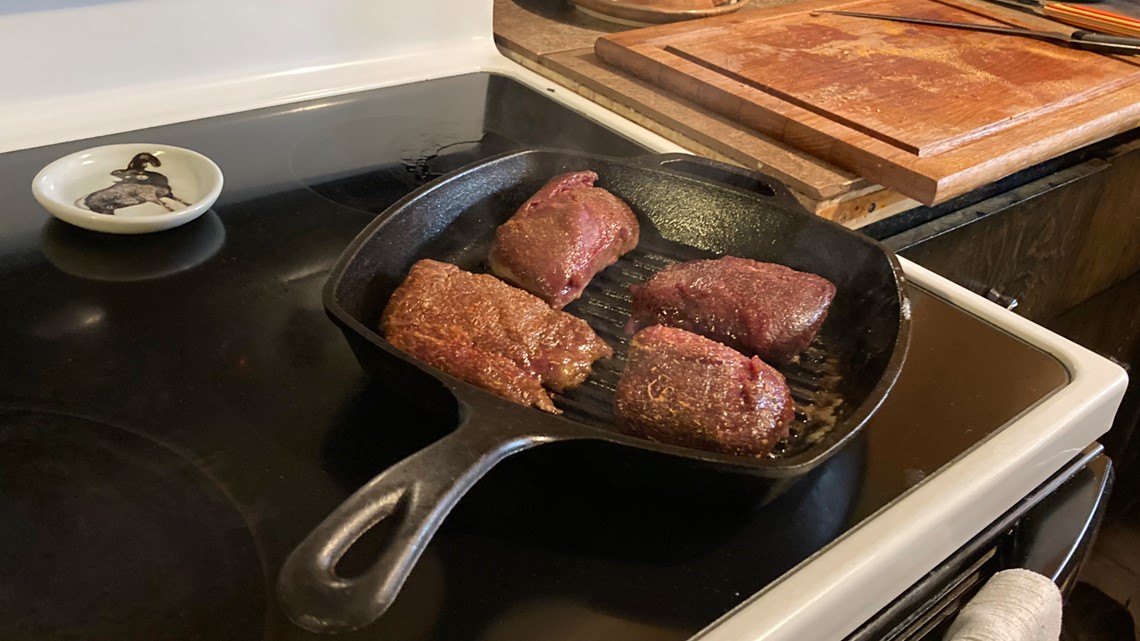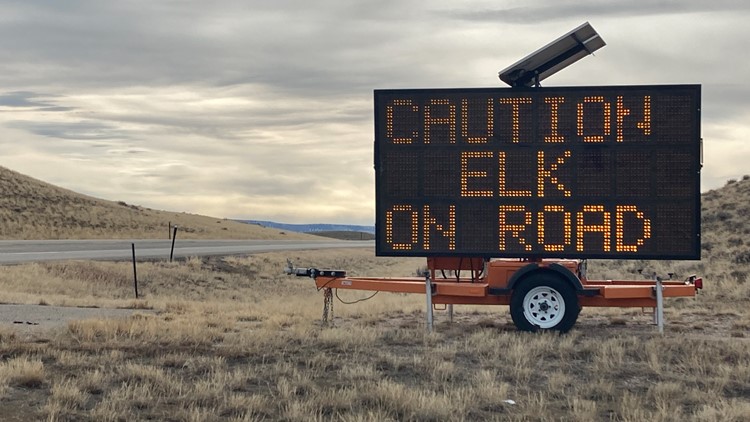LANDER, Wyo. — The aroma of sizzling meat in melted butter wafts from a cast iron pan while Jaden Bales shows his favorite way to cook up the best steak cuts from a big game animal.
The deep red backstrap pieces, similar to filet mignon of beef, are organic and could hardly be more local. They're from a mule deer hit by a car just down the road from Bales' rustic home in a cottonwood grove beneath the craggy Wind River Range.
Bales was able to claim the deer thanks to a new state of Wyoming mobile app that's helping get the meat from animals killed in fender benders from road to table and in the process making roads safer for critters.
State wildlife and highway officials rolled out the app — possibly the first of its kind in the U.S. — this winter when Wyoming joined the 30 or so states that allow people to collect roadkill for food.
The doe was crossing U.S. 287 south of Lander early on the morning of Presidents Day just as Marta Casey was headed out in her Subaru to go snowboarding.
She hadn't been snowboarding in years. A world traveler who'd only settled in Wyoming a year ago, little did she know she was in for a whole new experience in rural living.
“I tried to slow down and get around it,” said Casey. “It was very ... yeah.”
After a Wyoming Highway Patrol trooper took a report and promised to shoot the injured deer, Casey was a couple runs into snowboarding when she remembered the app she heard about from Bales, whom she had just recently met.
She alerted Bales, who soon found the doe and used the app to claim it by entering the species and verifying that it wasn't killed illegally.
Next thing Casey knew, Bales had hauled the doe home in his pickup truck and Casey was helping cut it up so they could hang the quarters in Bales’ garage.


Wyoming’s new roadkill feature within the state Department of Transportation app helps people quickly claim accidentally killed deer, elk, moose, wild bison or wild turkey after documenting the animal and reviewing the rules for collecting roadkill to eat.
Another purpose is to help people follow the rules. For safety reasons, roadkill in Wyoming may not be collected after dark, along interstate highways or in construction zones.
National parks, such as Yellowstone and Grand Teton, also are off-limits for roadkill retrieval.
Unlike in other states such as Alaska, roadkill meat in Wyoming can't be donated to anybody, including charities.
The whole carcass must be retrieved, not just the antlers or hide. In Oregon, which allows people to claim roadkill with an online form, people must surrender the head and antlers to wildlife authorities within five days but in Wyoming the whole animal is fair game.
The Wyoming app helps to collect data. By geotagging roadkill with their phones and documenting the species, app users will contribute to the data that help Wyoming wildlife biologists and highway officials decide where to install wildlife crossing signs and other ways of reducing critter deaths.
Wyoming is famous for its abundant wildlife and big game migration routes that are among the longest in North America. From keeping roadsides mowed to installing warning signs and multimillion-dollar wildlife underpasses along migration routes, Wyoming officials have been trying to reduce the at least 6,000 animals killed on the state's roads each year.
“That's quite a lot. And we know that the majority of those are mule deer,” Game and Fish Department spokesperson Sara DiRienzo said.
Mule deer, so named for their mule-like ears, inhabit the western half of North America and are generally bigger than the whitetail deer found across the continent.
Wyoming is home to about 400,000 mule deer, or roughly two for every three of the state's human residents. Although they're not rare and are still enthusiastically hunted, drought and diminishing habitat have played roles in reducing Wyoming mule numbers by almost 30% in the past 30 years.
“Mule deer already are struggling because of a number of factors. Roadkill collisions don't help that,” DiRienzo said.
Roadkill is indiscriminate, though, and includes a wide range of scavengers — coyotes, eagles and skunks, to name a few — that feed on highway-killed creatures and end up getting hit themselves.
“You can play the circle of life card and be like, ‘Well, there is never something that is wasted,’” Bales said. “But whenever you’ve got roadkill, it is really dangerous for any of the critters who come and try to eat it.”
In the case of Casey's deer, Bales, a spokesperson for the Wyoming Wildlife Federation that pushed for Wyoming roadkill legislation last year, got to the meat before any scavenging animals could risk getting hit.
You don't have to know the person who struck roadkill to be able to claim it in Wyoming, but it's not a bad idea. Bales said he never would have claimed the deer without knowing it had died only a few hours earlier and was still fresh.
Bales mailed in a lymph node from the animal to be tested for chronic wasting disease, a neurological illness similar to mad cow disease that's been spreading through U.S. deer populations for decades, and it came back negative.
After cutting up the deer, Bales and Casey sliced the heart and ate it fried in observance of a tradition that Bales, an avid hunter, grew up with. From there, they carved off roasts and steaks and smaller bits destined for grinding up like hamburger.
Casey had never hunted before and had only eaten wild game a couple times but liked the idea of at least making use of the animal that put her car in the body shop.
“It’s always been important to me to understand where our food comes from,” she said.
Bales prepared the prized backstraps using a family recipe that includes seasoned salt and fresh-ground fennel seeds.
The verdict? Tender, tasty... delicious.



